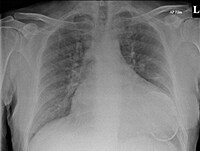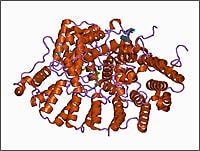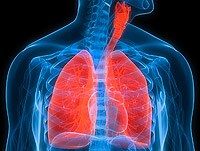1. Mutation to NF1 may desensitize tumor to BRAF inhibitors:
NF1--RAS--BRAF--MEK-ERK-MAPK
Desensitization to BRAF is expected in tumor with NF1 Mutant.
Resistance to Vemurafenib (Zelboraf) should be checked for Mutation to NF1 and RAS.
Recently prostate cancer has been associated with mutation in the PKC family which interacts with RAS suggesting RAS amplification or suppression may result. This could alter sensitivity to Cabozantinib,
"Cabozantinib (XL184) is an orally bioavailable tyrosine kinase inhibitor with activity against MET and vascular endothelial growth factor receptor 2." Smith et al.
REMEMBER NOW THERE ARE AT LEAST 4 MEDICATIONS DOWN THIS PATHWAYS
ANTI-EGFR/VEGF, ZELBORAF, CABOZANTINIB, MTOR INHIBITORS
-------------------------------------------------------------------
SUPPORTIVE EVIDENCES
1.1 "The BRAF kinase is a serine-threonine kinase that mediates signal transduction through the MEK-ERK pathway. An activating mutation of the BRAF kinase gene, located on exon 15, was recently found to result in a valine-to-glutamic acid substitution at amino acid 600 (BRAFV600E mutation) that is an oncogene in human cancer and the most common mutation in PTC [8]. In recent years, the BRAFV600E mutation has shown a high specificity for PTC, and its prevalence is highly variable, ranging from 30% to more than 80%, depending on the study. In the present study, the BRAFV600E mutation was identified by multiplex real-time PCR. This method is as sensitive as dual-priming oligonucleotide-based multiplex PCR (Seegene) for detecting BRAFV600E mutations.
The NF1 gene located on chromosome 17q11.2 encodes neurofibromin. The Ras-GAP is a
potentially functional domain of neurofibromin [9]. The Ras-GAP-related domain (Ras-GRD) accelerates the conversion of active Ras-GTP
to inactive Ras-GDP in various cell types and acts as a negative regulator of the
p21ras signaling pathway [10]. Ras GTPases interact with multiple pathways, including the RAF-MEK-ERK mitogen-activated
protein kinase pathway. Mutations in the NF1 gene result in abnormal cell growth and
in the formation of benign and malignant tumors [3]. Because BRAFV600E mutation and NF1 gene mutation are both involved in the MEK-ERK pathway, Koksal et al.[3] suggested that the development of PTC (papillary Thyroid cancer) in patients with NF1 may be associated with
the ras gene but that further evidence is necessary to confirm this association." FROM
Neurofibromatosis type 1 associated with papillary thyroid carcinoma incidentally detected by thyroid ultrasonography: a case report
Bu K Kim1et al!------------------------------------------------------------------------------------------------------------------------------------------------
1.2
Suppression of oncogenic Ras by mutant neurofibromatosis type1 genes with single aminoacid substitutions
NAKAfuku et al.
-------------------------------------------------------
1.3 "Once there, RAF proteins are activated and phosphorylated
by different protein kinases.24-28 Active RAF phosphorylates MEK that, in turn, phosphorylates and activates extracellular signal–regulated kinases 1 and 2
(ERK1/ 2).29 Several studies have supported the importance of this effector pathway by showing the ability of Raf and MEK to transform
rodent fibroblasts30 as well as the ability of RAF inhibitors to revert aspects of the RAS-driven transformed phenotype, such as growth in soft
agar.31
Non-NF1-associated low-grade gliomas in pediatric patients are classically associated with a truncated duplication of BRAF,[36–40] with some variability in the breakpoint and partner rearrangement.[41]
Various researchers have shown that in these low-grade tumors, the
fusion of BRAF with KIAA1549 leads to oncogene-induced senescence and
improved clinical outcome." Gilheeney et al
The second best-characterized RAS effector family is phosphoinositide 3-kinases (PI3Ks), which play important roles as mediators
of RAS-mediated cell survival and proliferation.32,33 When active, PI3K converts phosphatidylinositol (4,5)-bisphosphate (PIP2) into phosphatidylinositol (3,4,5)-trisphosphate (PIP3). PIP3,
in turn, binds the pleckstrin homology (PH) domain of Akt/PKB,
stimulating its kinase activity, resulting in the phosphorylation
of a host of other proteins that affect cell
growth, cell cycle entry, and cell survival. PI3K can also activate Rac,
and
this activation is involved in cytoskeleton
reorganization.34 The functional importance of the RAS-PI3K pathway will be more extensively discussed in the next sections.
Another well-characterized RAS effector pathway involves Ral-GEF proteins. RalGEF members (RalGDS, RGL, RGL2, and RGL3) link
RAS proteins to activation of the RalA and RalB small GTPases.35 The biological function of these proteins is not yet fully understood, although there is evidence that they play an important
role of this pathway in RAS-mediated transformation and tumorigenesis in vivo.36,37 Expression of RalGDS cooperates with constitutively activated RAF to induce focus formation, suggesting a cooperation of
RalGEF in RAS-mediated transformation in vitro.38
Apart from the above-mentioned effectors,
in recent years, an increasing number of molecules that specifically
interact with
RAS have been described, including Tiam1, p120GAP,
NF1, MEKK1, Rin1, AF-6, PKC-ζ, Nore1, Canoe, and others. These proteins
bind to RAS exclusively when it is in an activated
state39;
however, the physiological role of some of these effectors has not yet
been found. It has also been described that abnormal
RAS signaling causes deregulation of the Rho
GTPases family, including Rac1 and RhoA, but no direct association has
been found
yet." (Castellano and downward)
1.4. "neurofibromatosis type I (NF1). While an association of NF1 with
malignant gliomas has long been known in both adult and pediatric
patients,[32,33]
this mutation was not previously known to be associated with sporadic
GBM. By contrast, NF1-associated ras activation has been a hallmark of
pediatric low-grade gliomas, particularly for optic pathway gliomas.[33]
These tumors lack many of the characteristic abnormalities observed in
other astrocytic tumors and may help explain their excellent long-term
prognosis.[34]
The rarity of low-grade glioma-development in adults with NF1 suggests a
developmental period of sensitivity to this mutation in prenatal or
early childhood.[35]
Find out how a team of
electronic medical billing specialists can help you identify, correct,
track, and challenge denials to receive maximum reimbursements.
Information from Industry
1.5."The most visible features of NF-1 are the neoplastic manifestations
caused by the loss of Ras-GTPase-activating protein (Ras-GAP) activity
mediated through the GAP-related domain (GRD) of neurofibromin (NF1),
the protein encoded by NF1. However, the syndrome is also characterized
by cognitive dysfunction and a number of developmental abnormalities."
1.6"
Novel Tumor Suppressor Identified for Prostate Cancer
Researchers have identified the enzyme PKCζ, which acts as a tumor suppressor in prostate cancer and is part of a pathway that partly controls cell growth and metastasis…Azvolinski et al.







